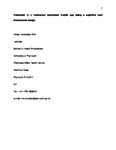Evaluation of a medication calculation mobile app using a cognitive load instructional design
| dc.contributor.author | McMullan, Miriam | |
| dc.date.accessioned | 2018-08-09T10:45:28Z | |
| dc.date.issued | 2018-10 | |
| dc.identifier.issn | 1386-5056 | |
| dc.identifier.issn | 1872-8243 | |
| dc.identifier.uri | http://hdl.handle.net/10026.1/11998 | |
| dc.description.abstract |
OBJECTIVE: For students attending healthcare courses, such as nursing and paramedicine, the ability to calculate medication dosages accurately is an essential but often a complex cognitive skill to be learned. This study aimed to determine whether a 'mastering medication calculation' mobile app, developed using an instructional design based on cognitive load theory, could improve students' medication calculation ability and self-efficacy. Additional objectives were: (1) To examine the correlations between students' medication calculation ability, self-efficacy and their numerical ability; (2) To explore how well medication calculation ability can be predicted by students' numerical ability and their medication calculation self-efficacy; (3) To obtain students' opinions regarding the mobile app's usefulness and usability. METHOD: A quasi-experimental study was carried out with a convenience sample of 60 second year UK university healthcare students who used the app for 8 weeks while in clinical practice. Students were given medication calculation ability and self-efficacy tests pre- and post-intervention. In addition, they were asked pre-intervention to complete a numeracy test and to complete a post-intervention survey to obtain their opinions on the usefulness of the app. RESULTS: Following the use of the app students were significantly more able (p = 0.004) and more confident (p < 0.001) in performing medication calculations. There were significant positive correlations found between students' numerical ability and medication calculation ability (p < 0.001) and between students' medication calculation ability and self-efficacy (p < 0.001). Hierarchical multiple regression analysis indicated numerical ability (β = 0.46, p < 0.001) and medication calculation self-efficacy (β = 0.46, p < 0.001) to be the strongest predictors of medication calculation ability, with age and gender being non-significant. All students indicated the app to be an excellent method to support them in learning how to perform medication calculations. CONCLUSION: This study indicated that the app's instructional design, based on cognitive load theory, significantly improved students' medication calculation ability and self-efficacy. Although the app's usability was highly rated by the students, further research is needed to determine if the app's instructional design can be used by learners of different levels of expertise and whether the design can be adopted for the learning of other complex cognitive skills. As numerical ability is essential for medication calculation ability, early identification and rectification of any numerical deficits is recommended. | |
| dc.format.extent | 72-77 | |
| dc.format.medium | Print-Electronic | |
| dc.language | en | |
| dc.language.iso | en | |
| dc.publisher | Elsevier | |
| dc.subject | Cognitive load theory | |
| dc.subject | Instructional design | |
| dc.subject | Mobile learning | |
| dc.subject | Medication calculations | |
| dc.subject | Self-efficacy | |
| dc.title | Evaluation of a medication calculation mobile app using a cognitive load instructional design | |
| dc.type | journal-article | |
| dc.type | Evaluation Study | |
| dc.type | Journal Article | |
| dc.type | Research Support, Non-U.S. Gov't | |
| plymouth.author-url | https://www.webofscience.com/api/gateway?GWVersion=2&SrcApp=PARTNER_APP&SrcAuth=LinksAMR&KeyUT=WOS:000442614500010&DestLinkType=FullRecord&DestApp=ALL_WOS&UsrCustomerID=11bb513d99f797142bcfeffcc58ea008 | |
| plymouth.volume | 118 | |
| plymouth.publication-status | Published | |
| plymouth.journal | International Journal of Medical Informatics | |
| dc.identifier.doi | 10.1016/j.ijmedinf.2018.07.005 | |
| plymouth.organisational-group | /Plymouth | |
| plymouth.organisational-group | /Plymouth/Faculty of Health | |
| plymouth.organisational-group | /Plymouth/Research Groups | |
| plymouth.organisational-group | /Plymouth/Research Groups/Institute of Health and Community | |
| dc.publisher.place | Ireland | |
| dcterms.dateAccepted | 2018-07-23 | |
| dc.rights.embargodate | 2019-7-24 | |
| dc.identifier.eissn | 1872-8243 | |
| dc.rights.embargoperiod | Not known | |
| rioxxterms.versionofrecord | 10.1016/j.ijmedinf.2018.07.005 | |
| rioxxterms.licenseref.uri | http://www.rioxx.net/licenses/all-rights-reserved | |
| rioxxterms.licenseref.startdate | 2018-10 | |
| rioxxterms.type | Journal Article/Review |


